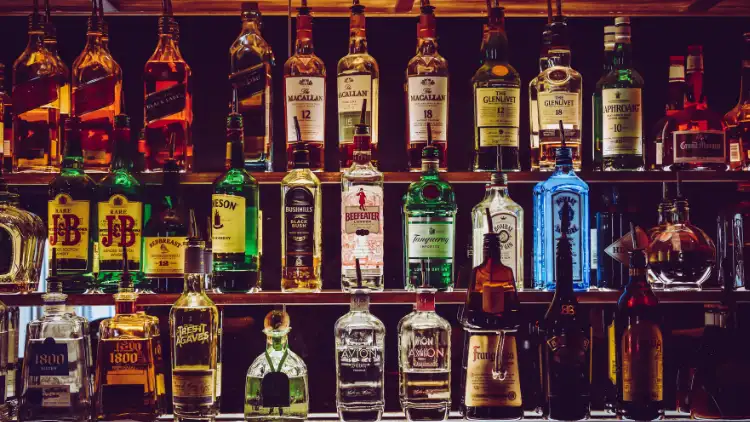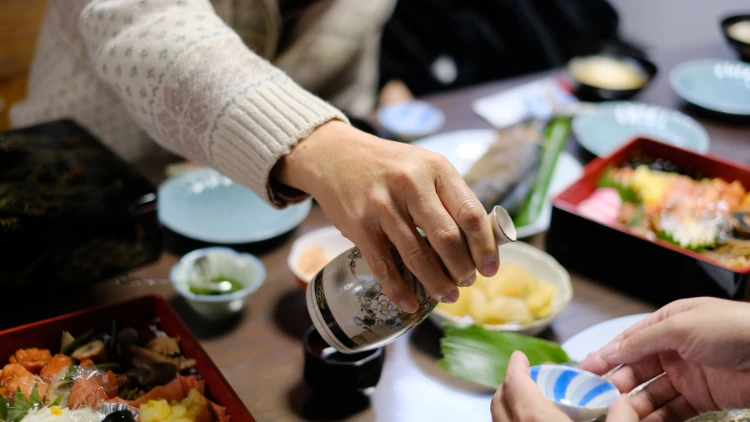
You may wonder if sake is keto-friendly, or if there certain types of sake with very little carbs.1
Sake is definitely something that can be enjoyed while following keto but dieters must keep the serving size and type in mind in order to be keto compliant.
This article will review how many carbs content are in sake, if sake contains sugar, the best low carb sake types (suggested brands), and the dry trick which refers to choosing sake with a dry taste profile since the fermentation process differs and results in less production of sugar.
How Many Carbs Content Are in Sake? (Number of Carbs in Sake)
A typical serving size of sake is between 1 and 3 ounces and one ounce of sake has 1.5 grams of carbohydrates. For reference, a standard shot is 1-1.5 ounces, and a standard glass of wine is 6 ounces.
The number of carbs in sake significantly increases as the serving size increases so it’s crucial to remain mindful and weary of how much someone plans to drink when following a keto diet.
While 1 ounce serving of sake has a very small number of carbs, 6 ounces of sake has 9 grams of carbohydrates which is too much for someone on keto.
While on keto, it’s recommended for the dieter to limit their carb intake to about 20-50 grams per day.2 Looking at those numbers, enjoying a glass of 6 ounces of sake would not be recommended on a keto diet but someone could definitely fit a 1-ounce portion of sake into their keto meal plan.
Does Sake Have a High Sugar Content? What Is the Glycemic Index of Sake?
Sake is not high in sugar as most brands and types have zero grams of sugar. It is important to note that certain sake classes such as Ginjo and Daiginjo may include added sugars to sweeten the sake.
Measuring the glycemic index of alcohol and other processed foods and drinks can be difficult to do. That being said, one study assigned sake the same glycemic index as beer which was 66.3
Other resources have labeled wines to have a glycemic index of zero.
Despite the confounding information, because most sake has zero grams of sugar, it is safe to assume that the glycemic index of sake is low.
The glycemic index (GI) of foods can be valuable to be aware of while following a keto diet because the GI shows how fast food absorbs into the bloodstream which is something that could impact ketosis.4
Furthermore, the glycemic index rating system is broken down into 3 ranges which are low (less than 55), medium (55 to 70), and high (anything more than 70).5 Using the rating of sake from the above research study, sake has a medium glycemic index.
Is Sake Suitable for Keto?
Yes, sake is acceptable to have while on a keto diet, making it a clear keto-friendly choice. But it is crucial to pay attention to the serving size consumed because larger amounts of sake do have a significant number of carbs and could throw someone out of ketosis.

Source: Chris F from Pexels6
There are also specific brands that would be better to enjoy while following keto because some brands are lower carb than others, specifically ordering or buying a dry sake would be best while on a keto diet because it is less sweet and would have fewer carbs and sugar.
It may be surprising to know that sake is primarily made of rice and water, which at first thought would sound like something that is not keto-approved because rice should always be avoided due to its high carb content. Due to the fermentation process of sake, it is actually relatively low carb making it safe to consume on keto, in small quantities.
Sake Alternatives
There are a variety of different types of alcohol that could be enjoyed while on a keto diet. Liquors such as rum, vodka, gin, tequila, and whiskey all have 0 grams of carbs per 1 serving size which is 1.5 ounces.

Source: Raphael Loquellano from Pexels7
Additionally, consuming smaller serving sizes can assist in addressing how to manage weight gained from alcohol.
Mixed drinks such as a martini or bloody mary will have a larger serving size at between 3-5 ounces and will also have a higher carb content at about 5.5 grams per serving. Brands and types of alcohol will have a significant impact on nutritional facts but most mixed drinks should be avoided on keto.
Most of the time beers would be best to avoid while following keto because typically beer has between 10-13 grams of carbs per serving. But there are some light options that would be okay because they have less than 3 grams of carbs per beer.
Carbs in Sake vs Wine
Since sake is considered a rice wine, those inquiring about its keto compatibility may also be curious about how it compares to other types of wine. Dry white wine could be used as a close substitute for sake, although sake may have a stronger taste.
Here is the breakdown of the number of carbs and sugar content comparing sake to both white and red wine. It is important to note that this is an estimation and the carb and sugar amount may vary based on brand.
- White wine (5 oz serving): 3.8 grams of carbs and 1.4 grams of sugar
- Red wine (5 oz serving): 3.8 grams of carbs and 0.9 grams of sugar
- Sake (1-ounce serving): 1.5 grams of carbs and 0 grams of sugar
While sake does have a lower number of carbs and sugar compared to both white and red wine, it’s important to remember that the serving size for sake is significantly smaller than the wines. That said, enjoying sake while on keto should be done in moderation because if not the number of carbs and sugar will be significantly larger.
Best Low-Carb Sake Options & Why They Are Low Carb
While there are a variety of different types of sakes, Sake comes in four different basic varieties. The dry options will contain fewer carbs and sugar and may be better to have while following keto.
A good rule of thumb is the sweeter the sake, the more calories and sugar present. When looking for a low-carb sake option it may be interesting to learn about the unexpected differences between low-fat and low-carb diets can be enlightening.

Source: Studio Japan via Canva.com8
Here are the four basic varieties of sake.
- Junmai-Shu: This type of sake is made with distilled alcohol and is made from pure rice. This one is actually more acidic and dry compared to other sakes, making it a good option for those on a keto diet.
According to MyFitnessPal, there are 1.5 grams of carbs in this type of sake per 1 ounce. - Honjozo-Shu: This variation is characterized as a light and more dry sake which is also a good option for those on a keto diet. MyFitnessPal says there are zero carbs in 1.5 grams of honjozo-shu sake.
- Ginjo-Shu: This is a sweeter variation and has a fruity and flowery flavor, making it a sweeter sake option. There are 1.4 grams of carbs per 1-ounce serving.
- Daignijo-Shu: Daignijo-Shu requires a more intensive fermentation process making it one of the most expensive types of sake someone can buy. This is a premium sake and should actually be avoided while on keto as 1.5 ounces of sake has 18 grams of carbs.
This type also has a sweet and fruity flavor like ginjo-shu.
The variation in carb counts between brands of sake is due to differences in the manufacturing process. It is brewed from rice and water and is fermented with koji mold and sake yeast.9
The alcohol content is between 13 and 17% and it actually contains 18 amino acids and multivitamins. Despite being made with rice, sakes’ fermentation process ends with an alcoholic beverage that is fairly low in carbs for a small 1.5-ounce serving size.
Premium brands of sake such as junami-shu and honjozo-shu are made from only rice, water, mold, and yeast whereas some of the cheaper and lower-quality sakes have added sugar and other ingredients that will cause an increase in carbs. Being aware of added sugars is very important while on keto as a lot of sweeteners are best avoided additionally, some may wonder is dextrose keto.
What To Order at a Restaurant & the Dry Trick
When looking for sake to order at a restaurant, junmai-shu and honozo-shu would both be good options as they are made from only rice, white, mold, and yeast and they are both low-carb.
Often sake is served at Japanese restaurants that offer sushi and some will also serve pho so knowing is pho keto friendly may be helpful. Sushi is also best known for being served with wasabi, so knowing is wasabi keto friendly may also be helpful.
The specific brand names will vary depending on which restaurant you are at but here are a few tips to keep in mind when ordering.
1. Location: Look for Japanese-made sake. Some restaurants will organize their different types of sake based on location. If they don’t, here are some Japan-made sake brands to look out for.
- Hakkaisan Tokubetsu Junmai: This is a clean, crisp, and dry sake with flavors of vanilla and herbs. While it is best served cold it can also be enjoyed hot.
- Dewazakura Cherry Bouquet Oka Ginjo: Ginjo is a sweeter sake and may be a great option for someone new to sake because it easily pairs with any food and will have more fruity and floral notes.
- Nanbu Bijin “Southern Beauty” Daiginjo: This sake has sweet, fruity flavors with hints of passionfruit, and pineapple while also being very crisp and dry.
- Kurosawa Junmai Kimoto: This sake offers a unique taste profile with hints of cocoa, white mushrooms, hazelnut, and sesame.
2. Freshness: For the highest quality taste, fresh is best. If possible, order a small 6oz bottle. Sometimes when ordering a glass it will come from an already-opened large bottle that could potentially have been sitting there for a while.
It is important to note that the entire 6oz bottle is not recommended to drink while following keto because of the high carb content, but this may work if shared with the table. Another option to scope out the freshest sake could be to look behind the bar and see which bottle was opened most recently.
3. Serving Size: Although sake is considered keto-friendly, it’s important to pay attention to serving size. 1 ounce of sake is 1.5 grams of carbs. There are a variety of different sizes someone could order in a restaurant.
- Shaku: The smallest amount which is about 0.5oz. This is a great option if someone wants a taste of the sake.
- Gurasu: The next available serving size is about 3.7 ounces. This could still be enjoyed while on a keto diet but the carb amount for this quantity would be about 5 grams of carbs, so someone would need to decide if that is realistic for their meal plan for the day.
- Ichigo: This serving size is 6 ounces and it would not be recommended to order this amount while on keto as it would be about 9 grams of carbohydrates.
4. Ask Questions: Most upscale Japanese restaurants actually have someone on staff that specializes in sake and making recommendations. If not, the server or bartender could be a great resource. Specifically asking for a recommendation for a low-carb or dry sake would be extremely helpful. Additionally, sometimes a restaurant will offer tastes.
Finally, the dry tip, asking for the driest sake available could be really helpful when ordering from a restaurant and following a keto diet. This is because dry sake will have a lower amount of sugar and carbs which is very important when following a keto diet.
Things To Look For at a Liquor Store
When looking to buy sake from a liquor store there are a few important things to keep in mind. Quality is important to consider when following a keto diet.
- Quality: To find the highest quality of sake try to avoid synthetic sakes. These typically have added ingredients such as sugar, rice malt, and seasonings.
These additional ingredients may be best to avoid while following keto and could increase the carb and sugar content in the sake. - Ask for Help: Often liquor store employees are fairly knowledgeable and could give some great recommendations of what sake to try based on someone’s flavor preferences, budget, and carb content. They could easily point someone in the direction of a dry sake as well, which would be preferred to look for while on keto.
- Sweet vs Dry: To figure out the sweetness of a sake bottle look at the back label to find a number with a + or – in front of it titled “Sake Meter Value” (SMV) or Nihonshu-do. This number will indicate how sweet or dry the sake is.
The higher the number the dryer the sake will be, for example, -7 would be a very sweet sake and +7 would be a very dry sake. Looking for a sake with a higher number would be good for keto diet and is keto approved. - Types: There is a huge variety of sakes available but some types to be on the hunt for that would be ok for keto diet would be junmai. This is typically a dry sake that is made with only rice, water, yeast, and koji, with no additional added ingredients to help keep the carb and sugar content down. Daiginjo is a super premium sake that would also be another good option to look for.
Sake is a very popular Japanese rice wine that can definitely be enjoyed while on keto. It is important to drink in moderation and remain mindful of what type of sake is consumed to make sure the carb content stays low. Following tips like opting for dry varieties helps ensure sake remains keto-friendly.
Frequently Asked Questions
What Other Alcoholic Beverages Are Keto-Friendly?
The best types of alcohol on a keto diet would be liquors such as rum, vodka, gin, tequila, and whiskey as they all contain 0 grams of carbs. Wines, beers, and mixed drinks would be best in moderation as the number of carbs in those can vary between 4 and 15 carbs per serving, although more brands are adding in low or zero-carb options.
How Much Sake Can I Drink on Keto?
While sake is keto-friendly, it’s important to keep the serving size small. For 1 ounce of sake, there are 1.5 grams of carbs making that quantity great to enjoy while on a keto diet.
Larger quantities such as 5 ounces, comparable to a glass of wine, are closer to 9 carbs of carbs and should be avoided while on a keto diet.
What Other Types of Alcohol Should I Avoid on a Keto Diet?
Mixed drinks and beer are typically very high in carbs, most being over 10 grams of carbs per serving so these would be best to avoid while on a keto diet.
References
1sakai000. “Senior to drink sake.” Canva. Accessed 9 April 2023. <https://www.canva.com/photos/MADEHVviUq8-senior-to-drink-sake/>
2Batch, J. T., Lamsal, S. P., Adkins, M., Sultan, S., & Ramirez, M. N. (2020). Advantages and Disadvantages of the Ketogenic Diet: A Review Article. Cureus, 12(8). <https://www.ncbi.nlm.nih.gov/pmc/articles/PMC7480775/>
3Oba, S., Nanri, A., Kurotani, K., Goto, A., Kato, M., Mizoue, T., Noda, M., Inoue, M., & Tsugane, S. (2013). Dietary glycemic index, glycemic load and incidence of type 2 diabetes in Japanese men and women: the Japan public health center-based prospective study. Nutr J. <https://www.ncbi.nlm.nih.gov/pmc/articles/PMC4029149/>
4Esfahani, A., Wong, J. M. W., Mirrahimi, A., Srichaikul, K., Jenkins, D. J. A., & Kendall, C. W. C. (2009). The glycemic index: physiological significance. J Am Coll Nutr. <https://pubmed.ncbi.nlm.nih.gov/20234030/>
5BetterHealth Channel. (2023). Carbohydrates and the glycaemic index. Healthy Eating. <https://www.betterhealth.vic.gov.au/health/healthyliving/carbohydrates-and-the-glycaemic-index>
6Chris F. “Assorted Wine Bottles.” Canva. Accessed 9 April 2023. <https://www.canva.com/photos/MADGv1nEQsk-assorted-wine-bottles/>
7Raphael Loquellano. “Bottles on Shelf With Bottles.” Canva. Accessed 8 April 2023. <https://www.canva.com/photos/MAElsJEfqWI-bottles-on-shelf-with-bottles/>
8Studio Japan. “Hand with Bottle Pouring Sake to a Cup.” Canva. Accessed 9 April 2023. <https://www.canva.com/photos/MAEMsitvQCY-hand-with-bottle-pouring-sake-to-a-cup/>
9Zhang, K., Wu, W., & Yan, Q. (2020). Research advances on sake rice, koji, and sake yeast: A review. Food Sci Nutr, 8(7). <https://www.ncbi.nlm.nih.gov/pmc/articles/PMC7382144/>